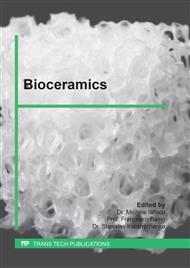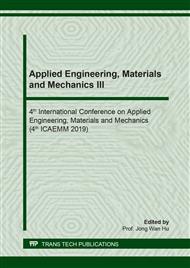[1]
Riskesdas, Riset Kesehatan Dasar, Badan Penelitian dan Pengembangan Kesehatan Departemen Kementerian Kesehatan RI, Jakarta, (2013).
DOI: 10.14203/press.298
Google Scholar
[2]
S. Arabnejad, R. B. Johnston, J. A. Putra, B. Slingh, M. Tanzer, D. Pasini, High-Strength Porous Biomaterials For Bone Replacement: A Strategy To Assess The Interplay Between Cell Morphology, Mechanical Properties, Bone Ingrowth and Manufacturing Constraints, Acta. Biomater. 30 (2016) 345-356.
DOI: 10.1016/j.actbio.2015.10.048
Google Scholar
[3]
A. Oryan, S. Alidadi, Reconstruction Of Radial Bone Defect In Rat By Calcium Silicate Biomaterials, Life Sci. 201 (2018) 45-53.
DOI: 10.1016/j.lfs.2018.03.048
Google Scholar
[4]
A. S. Kupiec, K. Pluta, A. Drabczyk, M. Wlos, B. Tyliszczak, Synthesis and Characterization Of Ceramic - Polymer Composites Containing Bioactive Synthetic Hydroxyapatite For Biomedical Applications, Ceram. Int. 44(12) (2018) 13630-13638.
DOI: 10.1016/j.ceramint.2018.04.199
Google Scholar
[5]
J. Latocha, M. Wojansinski, K. Jurczak, S. Glerlotka, P. Sobieszuk, T. Clach, Precipitation of hydroxyapatite nanoparticles in 3D-printed reactors, Chem. Eng. Processing: Process Intensification, 133 (2018) 221-233.
DOI: 10.1016/j.cep.2018.10.001
Google Scholar
[6]
Y. S. Wu, Y. H. Lee, H. C. Chang, Preparation and characteristics of nanosized carbonated apatite by urea addition with coprecipitation method, Mater. Sci. Eng. C, 29(1) (2009) 237-241.
DOI: 10.1016/j.msec.2008.06.018
Google Scholar
[7]
C. C. Kee, H. Ismail, A. F. M. Noor, Effect of Synthesis Technique and Carbonate Content on the Crystallinity and Morphology of Carbonated Hydroxyapatite, J. Mater. Sci. Technol. 29(8) (2013) 761-764.
DOI: 10.1016/j.jmst.2013.05.016
Google Scholar
[8]
N. Akilal, F. Lemaire, N.B. Bercu, S. Sayen, S.C. Gangloff, Y. Khelfaoui, H. Rammal, H. Kerdjoudj, Cowries Derived Aragonite As Raw Biomaterials For Bone Regenerative Medicine, Mater. Sci. Eng. C Mater. Biol. Appl. 94 (2019) 894-900.
DOI: 10.1016/j.msec.2018.10.039
Google Scholar
[9]
R. Othman, Z. Mustafa, C. W. Loon, A. F. M. Noor, Effect Of Calcium Precursors and pH On The Precipitation Of Carbonated Hydroxyapatite, Procedia Chem. 19 (2016) 539-545.
DOI: 10.1016/j.proche.2016.03.050
Google Scholar
[10]
E. Landi, G. Celotti, G. Logroscino, A. Tampieri, Carbonated Hydroxyapatite As Bone Substitute, J. Eur. Ceram. Soc. 23(15) (2003), 2931-2937.
DOI: 10.1016/s0955-2219(03)00304-2
Google Scholar
[11]
W. H. Yang, X. F. Xi, J. F. Li, K. Y. Cai, Comparison of Crystal Structure Between Carbonated Hydroxyapatite and Natural Bone Apatite with Theoretical Calculation, Asian J. Chem. 25(7) (2013) 3637-3678.
DOI: 10.14233/ajchem.2013.13709
Google Scholar
[12]
A. Bigi, E. Boanini, M. Gazzano, Ion substitution in biological and synthetic apatites, Biomineralization Biomater. Fundamentals Appl. (2016) 235-266.
DOI: 10.1016/b978-1-78242-338-6.00008-9
Google Scholar
[13]
S. Rujitanapanich, P. Kumpapan, P. Wanjanoi, Synthesis of Hydroxyapatite from Oyster Shell via Precipitation, Energy Procedia, 56 (2014) 112-117.
DOI: 10.1016/j.egypro.2014.07.138
Google Scholar
[14]
D. Nunez, E. Elgueta, K. Varaprasad, P. Oyarzun, Hydroxyapatite nanocrystals synthesized from calcium rich bio-wastes, Mater. Let. 230 (2018) 64-68.
DOI: 10.1016/j.matlet.2018.07.077
Google Scholar
[15]
Y. Rizayanti, Y. Yusuf, Optimization of the Temperature Synthesis of Hydroxyapatite from Indonesian Crab Shells, Int. J. Nanoelectronics Mater. 12(1) (2019) 85-92.
Google Scholar
[16]
N. V. Stupar, S. Novkovic, I. Jezdic, Supplementation with Bio-Calcium from Shells Pinctada maxima in Postmenopausal Women with Decreased Mineral Bone Density–Pilot Study, Srp. Arh. Celok. Lek. 137(9-10) (2009) 518-523.
DOI: 10.2298/sarh0910518v
Google Scholar
[17]
D. Nunez, E. Elgueta, K. Varaprasad, P. Oyarzun, Hydroxyapatite nanocrystals synthesized from calcium rich bio-wastes, Mater. Lett. 230 (2018) 64-68.
DOI: 10.1016/j.matlet.2018.07.077
Google Scholar
[18]
C. W. Loy, K. A. Mator, W. F. Lim, S. Schmid, N. Zainuddin, Z. A. Wahab, A, N. Alassan, H. M. Zaid, Effects of Calcination on the Crystallography and Nonbiogenic Aragonite Formation of Ark Clam Shell under Ambient Condition, Advances Mater. Sci. Eng. 2016 (2016) Article ID 2914368.
DOI: 10.1155/2016/2914368
Google Scholar
[19]
M. Sari, Y. yusuf, Synthesis and Characterization of Hydroxyapatite based on Green Mussel Shells (Perna viridis) with Calcination Temperature Variation Using the Precipitation Method, Int. J. Nanoelectro. Mater. 11(3) (2018) 357-370.
DOI: 10.1088/1757-899x/432/1/012046
Google Scholar
[20]
J. Liu, X. Ye, H. Wang, M. Zhu, B. Wang, H. Yan, The influence of pH and temperature on the morphology of hydroxyapatite synthesized by hydrothermal method, Ceram. Int. 29(6) (2003) 629-633.
DOI: 10.1016/s0272-8842(02)00210-9
Google Scholar
[21]
E. Landi, G. Celotti, G. Logroscino, A. Tampieri, Carbonated Hydroxyapatite As Bone Substitute, J. Eur. Ceram. Soc. 23(15) (2003) 2931-2937.
DOI: 10.1016/s0955-2219(03)00304-2
Google Scholar



